When you sit down to write an article, where do you start? There are many different ways to write an article, but having a content outline makes the process significantly easier and more effective.
When talking with customers, I often hear that creating a blog or article outline is difficult. Some people even say it’s intimidating as they feel like they’re constricting their creativity. But is it really so?
Indeed, there are several steps involved in creating a comprehensive content outline. True, it can be detailed and time-consuming. And yes, it takes time. However, based on my experience working with content creation processes, it’s absolutely worth the effort. The data supports this claim: content marketing generates three times as many leads as outbound marketing and costs 62% less, highlighting the efficiency gains that result from strategic planning (Demand Metric).
Whenever I want to write an article, I outline it first. This approach helps me determine my topics before I start writing, ensuring that the content yields the desired results rather than generating traffic randomly. The time invested in preparing a detailed content outline can significantly increase the return on investment of your content efforts.
In this practical guide, I’ll walk through the complete process of creating a content outline from start to finish, including research methodology, essential information for your outline, and formatting strategies that make your content stand out.
So, sit back, and relax!

TL;DR
- A content outline is a roadmap for an article, and it is a tool used for organizing any kind of content.
- Creating an outline helps organize your thoughts and ideas, ensuring that your final product is well-developed and cohesive.
- Proper research before writing ensures that the article covers all topics of interest to your audience, adding value to the reader.
- Outlining makes it easier for readers to follow, quickly finding the topic they are looking for without skimming.
- Outlining reduces the chances of writer’s block, offering inspiration to the writer.
- A clear outline enables scaling content creation and writing processes, publishing multiple blog posts or articles each day.
- An outline can save money by reducing content creation costs.
- A detailed content outline may seem tedious and time-consuming, but it is worth the effort.
- A content outline provides a structured approach to writing, making the final product much more effective.
- Using content outline generators, like SEOwind, can significantly increase the efficiency of the content creation process.
What Is Content Outline?
“A content outline is a structured list of topics, headings, and key points that you will cover in your article or blog post. Rather than a simple collection of bullet points, an effective content outline serves as a comprehensive blueprint for your content creation process.” says Tom Winter, Founder of SEOwind.
Think of a content outline as the skeleton or architectural framework of your article. It provides an overview of what content will be included and how different sections connect to create a cohesive narrative. This outline becomes part of your broader content strategy, guiding writers through the entire creation process.
Content outlines prove especially valuable for comprehensive blog posts or articles with multiple sections. They’re also essential for website content planning, helping ensure consistency across different pages and maintaining brand voice throughout various content pieces.
Why Create an Article Outline?
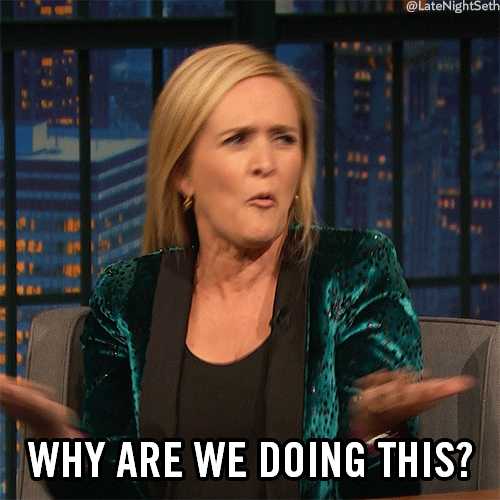
Many content creators question whether outlining is necessary, viewing it as time-consuming or potentially limiting creativity. However, article outlines are crucial for producing well-structured content with proper keyword integration and comprehensive coverage of important topics. The evidence is compelling: 74% of marketers report that content marketing has directly helped generate demand and leads. In comparison, 50% of bloggers who publish content 2–6 times per week report strong results.
Structure Keeps Your Thoughts Well-Organized
Creating a blog outline or article outline helps organize your thoughts and ideas before you begin writing. This process ensures your final product is well-developed and cohesive, containing all valuable information from the reader’s perspective rather than a collection of random thoughts that are difficult to follow.
Outlines help you stay focused on major points and structure information in a logical manner. You can easily rearrange topic order or omit sections if needed. When you start writing an article directly, you might miss crucial elements or disrupt the natural flow. The content might appear scattered without proper structure, making it difficult for readers to follow your reasoning.
Deliver More Value to Your Reader
Thorough research before writing ensures you’re covering topics that genuinely interest your audience. This approach helps uncover their interests, needs, questions they ask, and problems they’re trying to resolve. You’ll stop guessing and bring more relevant, valuable content to your audience based on actual data and search behavior.
Easy to Follow for Your Reader
Outlining your content makes it significantly easier for readers to navigate. By providing clear structure through headings and subheadings, readers can quickly locate the topics they’re seeking without having to skim through lengthy articles. This improved user experience often leads to more extended engagement and better content performance.
Eliminate Writer’s Block
Content outlines serve as lifesavers when you’re stuck on what to write next. Instead of staring at a blank page, wondering about your next topic, refer to your outline for inspiration and direction. Everything you need to write is clearly stated and organized, allowing you to maintain creative flow without interrupting research.
Scale Content Creation and Quality
Content outlines enable the effective scaling of the content creation process. Instead of producing one or two articles weekly, you can focus on quality while publishing multiple blog posts or articles consistently. With clear outlines, it becomes much easier to outsource writing content to external or internal copywriters. Writers, even those unfamiliar with your industry, will know exactly what they need to write about.
A digital marketing agency that standardized its case study outlines experienced 50% faster production of case studies compared to previous ad hoc approaches. Case study landing pages built from these outlines saw a 45% increase in engagement (time on page and downloads). The agency reported a 35% decrease in client revision requests, freeing up hours for new client acquisition.
Reduce Content Creation Costs
Outlines significantly reduce content creation expenses. When you ask external copywriters to write articles without clear direction or outlines, they’ll likely provide content that’s easy for them to write rather than what you actually need. This approach guarantees revision cycles and additional costs.
For content that ranks well and incorporates SEO technicalities, clear directions become essential. Without proper outlines, you’ll spend time fixing weak drafts, and time equals money. Good outlines mean increased collaboration, clear expectations, higher content quality, quicker delivery, and lower overall costs.
Produce Content That Drives Traffic
Outlines help create content that drives traffic because it matches what your audience actively searches for. You’re no longer creating random content but relevant material that people will be interested in reading. When you strengthen your content outline with SEO aspects, the magic happens – you’ll see positive influences on both traffic and conversions.
As Joe Pulizzi reminds us, “Content marketing is a commitment, not a campaign.” This long-term perspective requires structured, repeatable processes, such as outlining, that ensure sustainable content marketing success.

Ensure SEO Optimization
Having a comprehensive article outline gives you proper keyword preparation. When you write the article later, you’ll already know which keywords to include and where to place them strategically for maximum SEO impact.
Old School vs. SEOwind: How Content Outlines Get Done Today
Creating content outlines used to be a slog, with hours wasted toggling between tools, manual keyword wrangling, and endless guesswork. That old-school grind still works if you have the time and patience, but it’s inefficient and prone to mistakes.
Enter SEOwind: an AI-powered shortcut that slashes research time tightens SEO focus and delivers ready-to-go outlines in minutes. Here’s how the traditional manual approach compares to the smarter, faster SEOwind method of building content blueprints that actually rank and convert.
| Aspect | Old Way (Manual Content Outline) | SEOwind Way (AI-Powered Content Outline) |
|---|---|---|
| Research | Manually juggle multiple tools (Google, Ahrefs, Semrush, etc.) | Automated SERP analysis and keyword research in one interface |
| Time Investment | Hours to days to gather data, analyze competitors, and structure | 5–10 minutes to generate a solid outline draft |
| Keyword Handling | Manually cluster and integrate keywords, often across multiple tools | AI suggests primary and secondary keywords with search volume |
| Outline Creation | Handcraft headings/subheadings and add context from scratch | AI generates title, meta, outline, and keyword suggestions |
| Revision & Refinement | Iterative manual edits, risk of missing SEO nuances | Easy one-click regenerations, competitor outline insights |
| SEO Optimization | Separate keyword research and SEO checks, easy to overlook details | SEO integrated from the start with strategic keyword placement |
| Scalability | Limited by manual effort and coordination | Scale content production easily; outsource with clear briefs |
| Cost Efficiency | Higher cost due to time spent and revision cycles | Lower costs with less back-and-forth and faster turnaround |
| Creativity Impact | Perceived constraint but flexible | Balanced – AI handles structure, humans add unique insights |
| Outcome Quality | Varies depending on thoroughness and experience | Consistently high due to data-driven, SEO-focused outlines |
| User Effort | Heavy lifting in research, drafting, and editing | Mostly review and customize AI suggestions |
In a nutshell: the old way is a grind – effective but slow and prone to errors or missed SEO opportunities. SEOwind cuts through the noise with automation, structure, and data-backed insights, letting you focus on sharpening the message, not hunting for crumbs.
Create Content Outlines with SEOwind: A Step-by-Step Process
We’ve prepared a separate tutorial covering all steps of SEOwind brief creation process. To learn more visit: How to create a content brief with SEOwind? Best practices in SEOwind
With SEOwind, one of its feature outline generators, you can create battle-ready content outlines in just 5 simple steps and under 10 minutes.
Here’s how:
Step 1: Choose a target keyword
Start with a keyword that’s relevant and has a solid search volume.
(Pro tip: long-tail keywords are gold, especially when you’re starting out.)
Step 2: Click “Create a Brief”
SEOwind takes it from here:
- It analyzes the SERP
- Prefills your title, meta, outline, and keyword suggestions
- Packages everything into one clean, centralized view
Step 3: Review and refine the AI-generated outline
You get an 80% solid draft from the AI. Your job is the final 20%.
- Not happy with the first version? Regenerate in 1 click
- Dive into competitor outlines
- Add/delete/edit using the built-in outline editor
- Layer in your unique insights, angles, and real value
(Bonus tip: Source real questions from Google, Reddit, and Quora to deepen relevance.)
Step 4: Add secondary keywords
These supporting terms help you broaden search visibility and capture additional traffic.
Step 5: Generate your AI article
Once your outline is ready, hit “Generate AI Article.” In seconds, SEOwind produces a complete first draft built on your strategy.
What once felt like a scattered, draining task is now a streamlined system. SEOwind was built out of frustration. Today, it powers content workflows that are faster, smarter, and optimized for search intent.
If your goal is to rank and do it without the chaos, this is your tool.

Content Outline Examples and Sample Template
Effective content outlines should include the topic (working title), headings and subheadings for content structure, critical points under subheadings when needed, relevant questions, and target keywords categorized by importance.
Always start content outlines with the article’s topic, then identify appropriate keywords after conducting research. Include essential keywords in article titles, plan headings, and subheadings based on research, and use keywords within articles or as subheadings when appropriate.
After determining the keywords, decide on the article tone while clearly understanding the content goals, target audience, and unique selling propositions to highlight throughout the article.
Content Outline Template
Topic: Working title
Article Guidelines:
→ Focus keyword: {keyword} (search volume: X)
→ Secondary keywords: {keyword 1}, {keyword 2}, {keyword 3}
→ Suggested article length: [word count]
→ Suggested number of headings: [number]
→ Suggested number of images: [number]
SEO Elements:
→ Title
→ Meta description
Article Structure:
→ Heading 1: Key takeaways and context
→ Heading 2: Key takeaways and context
→ Heading 3: Key takeaways and context
Research Sources:
→ Relevant links and references
→ Supporting data and statistics
→ Industry insights and examples
SEOwind content outline example
Here you can find a sample content outline created with SEOwind for the primary keyword “how to brew coffee at home”.
This is how the outline looks in the system:
Once you have your outline ready you can either share it via a link or copy it to your doc file. You can access this content outline here [Content Brief] The Best Ways to Brew Coffee at home, According to Baristas
It will look as follows:
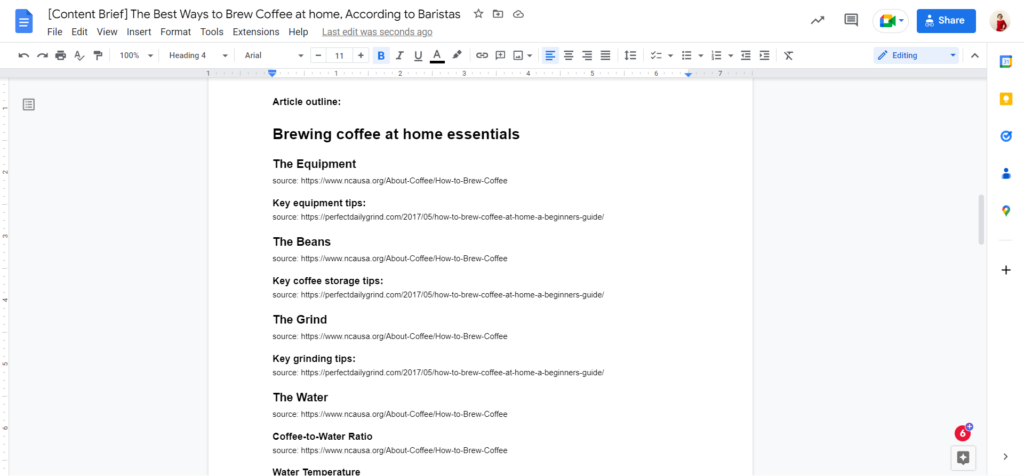
Common Content Outline Mistakes to Avoid
Several critical mistakes can undermine the effectiveness and content performance of an outline.
Avoid relying solely on basic AI prompts with general-purpose large language models (LLMs) like ChatGPT without providing specific data from keyword and search engine results page (SERP) research. ChatGPT is a language model, not a knowledge model, and lacks necessary real-time SEO data, leading to generic or inaccurate outlines.
Using vague or brief prompts proves ineffective, as AI requires clear, detailed instructions and ample context to produce useful results. Don’t expect high-quality results from one-line prompts – providing valuable context represents 99% of effective prompting for content creation.
Skipping keyword and content research before creating outlines leads to weak content that won’t perform well in search results. Additionally, don’t treat AI as a search engine for retrieving information it wasn’t trained on or doesn’t have real-time access to. Instead, feed AI the knowledge it needs to make informed decisions.
How to Outline an Article [old way, manual process]
The purpose of a content outline extends beyond simply organizing thoughts – it requires a strategic, data-driven approach that often leverages AI as an assistant while maintaining human expertise for refinement and unique insights.
Every article should begin with clearly defined goals, an understanding of search intent, and thorough audience research. Don’t start with blank pages or simple prompts like “Write an article about…” Instead, follow this comprehensive process.
Step #1: Define Your Topic Through Research
Creating effective content outlines starts with comprehensive research rather than assumptions. Find out what the topic involves, what people are searching for, and what unique value you can offer.
Conduct Keyword Research
Identify the right target keyword that’s relevant to your audience and website. Useful tools for this process include Google’s Keyword Planner, Semrush, and Ahrefs. Start your content brief by listing keywords at the top of your outline – this becomes valuable when gathering information and drafting content.
LLMs can assist in clustering keywords into groups to understand how they work together. Still, they need proper data to make informed decisions and avoid hallucinations. Keeping all relevant keywords in your outline eliminates the need to switch between platforms while working.
Analyze Search Intent
Before writing, understand who your article targets. Examine user search intent and the “why” behind search queries. What are people hoping to achieve through their searches?
The simplest way to understand search intent is to google your target keyword and analyze the SERPs. For “content outline,” the search intent is clearly informational – people want to learn about content outlines and how to create them. This explains why most search results are educational articles.intent? Google your target keyword and look at the SERPs. Let’s take the content outline as an example.
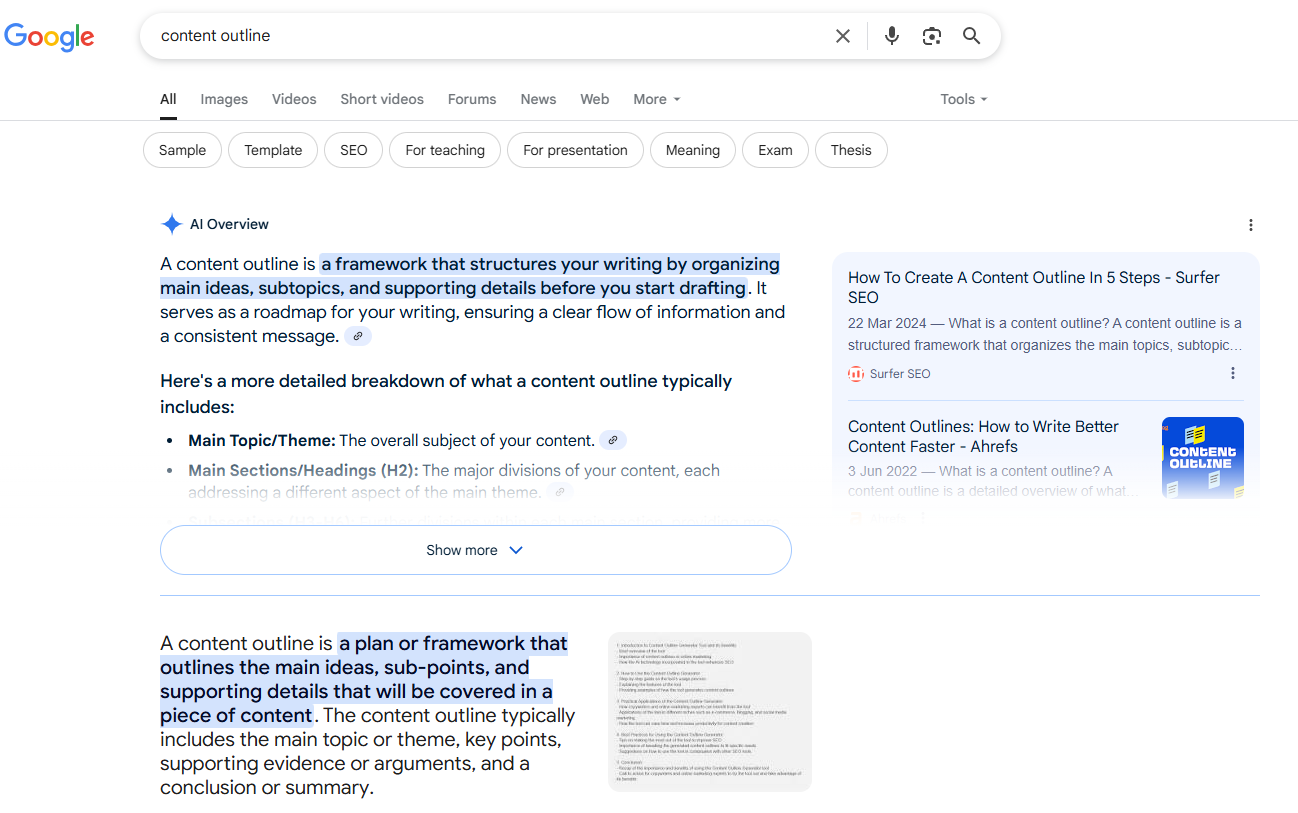
Analyze Top-Ranking Articles
When you analyze top-ranked articles on your topic, you’ll understand what content templates resonate with your audience and identify unexplored angles that resonate with your target demographics. Examine competitor outlines (headings and subheadings) to gain insights into structure and topics, but don’t simply replicate them – use them as inspiration while striving to create superior outlines that add unique value and fill gaps.
Step #2: Define Your Unique Value
Ask yourself these critical questions: What sets your content apart? What unique perspective are you bringing to this topic? What specific value will your content provide that competitors don’t offer?
After identifying your target keyword and understanding search intent, define your angle – what will make your content stand out from other articles on the topic.
Determine Your Working Title
Choose a working title that clearly indicates the direction, even if it’s not final. Great article titles should be attention-grabbing, using numbers and powerful words, specific enough to rank for long-tail keywords, and actionable by telling readers what they’ll learn and how it contributes value.
Analyzing SERPs reveals that Google prioritizes guides and how-to articles for content outline topics. Content should be educational and informational to rank well.
To obtain top positions, you’ll need to produce original and in-depth material – also known as skyscraper content. Detailed SERP research offers valuable insights into recommended word counts, ranking keywords, and effective heading and subheading structures.
Let’s get back to the SERPs. Here are the results for “content outline”:
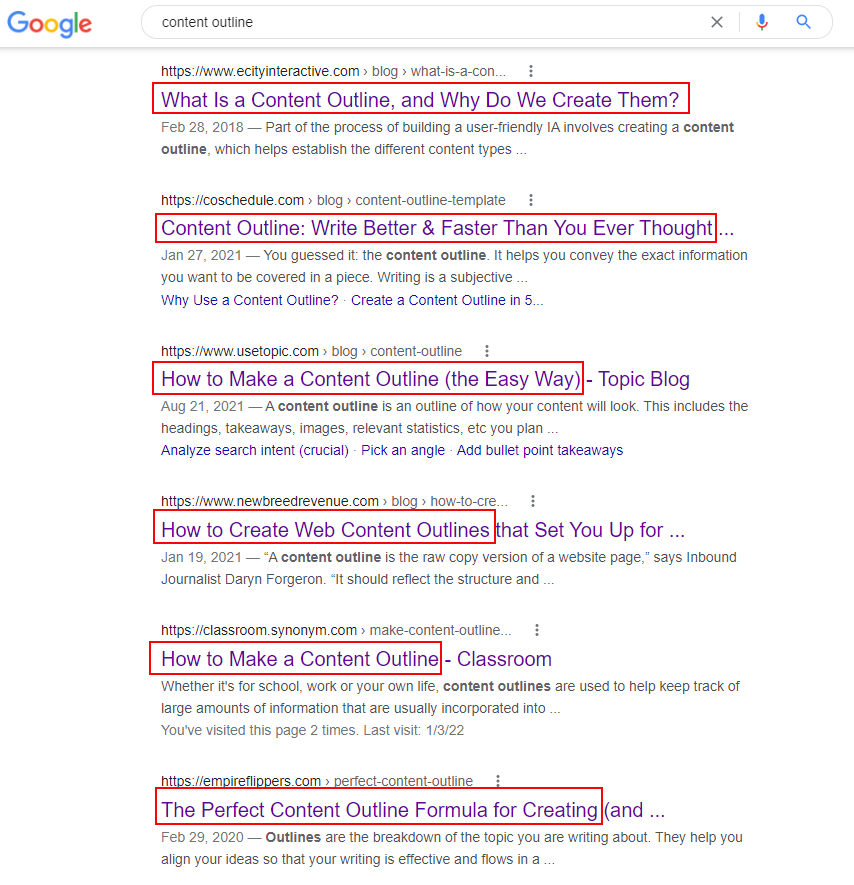
Step#3: Create Headings and Subheadings
With your H1 established from the previous step, develop H2s, H3s, and H4s as needed. Structure them logically to improve readability for humans and help search engines understand content hierarchy.
Your approach should include reviewing SERPs to identify valuable headings for your outline, structuring them in logical order, and adding unique value through customer questions and challenges. Try naming headings meaningfully so they convey clear messages about the information contained in each section. Each header should correspond to major search items associated with your primary keyword.
Step #4: Add Context Under Heading
Going beyond basic headings significantly improves outline effectiveness. Include context under headings so content writers know specifically what to write about, removing the guesswork from the equation.
Consider what you want readers to take away from each section using bullet points where appropriate. Add relevant statistics, internal links, and up-to-date data that make articles more credible. Include internal content links that complement your topic well.
Step #5: Incorporate Audience Questions
Research questions your target audience asks related to your topic. Several valuable sources provide this information:
- Google’s ‘People Also Ask’ (PAA)
The ‘People Also Ask‘ box appears in SERPs and displays questions that searchers ask related to your keyword, helping you understand what readers are seeking online.
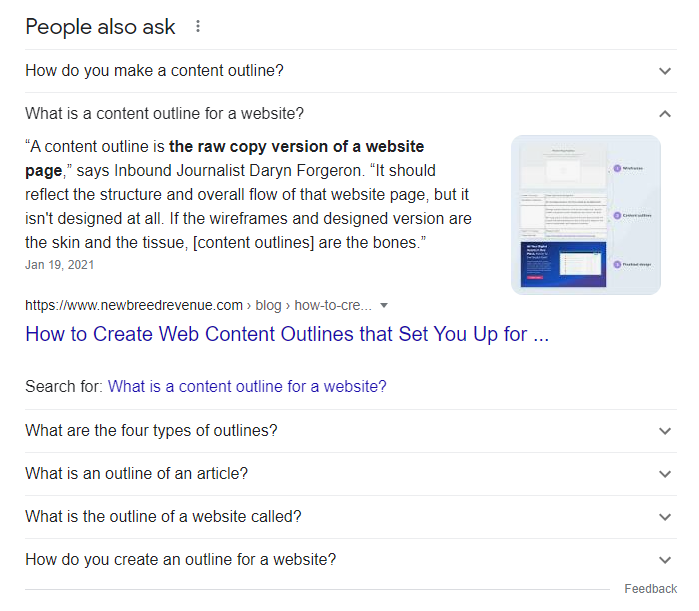
- Ahrefs questions
In Keywords Explorer, enter your target keyword and review the questions section for additional audience interests.

Additional tips: You can also investigate Quora or Reddit for further inspiration. Using these questions as headings or subheadings in articles may help content appear as featured snippets.
Step #6: Include Additional Supporting Information
Introduction and Conclusion Planning
Having complete introductions and conclusions in outlines provides clear article goals and states what audiences will learn. Keep these sections around 150 words on average. They serve as entrance and exit doors that don’t require excessive length.
Introductions should hook readers and pull them down the page. At the same time, conclusions summarize everything readers have learned and provide final punctuation. Include call-to-action labels in your outline where appropriate.
Links, Examples, and Data Integration
Include examples you want to write about or data you’ve collected. This means you’ve identified strong arguments to support your points while keeping content organized and saving time during the writing process.pport your point. So, adding links or data to your section will keep you organized, and you can support your claims. This process will also save a lot of time when you write your blog.
Frequently Asked Questions regarding content outline

How many headings should my outline have?
If you’re wondering how many headings your outline should have, we’ve got it covered. Just check out our video!
The foundation of your outline is your headings. It’s time to arrange your data once you’ve created them.
What is the order of an outline?
Generally, outlines have three main parts: introduction, body, and conclusion. The introduction should introduce your topic and explain its importance. The body should discuss each point in detail. At the same time, the conclusion summarizes key points and offers final thoughts or calls to action.
When should you create an outline?
Create outlines for various types of content, including blog posts, articles, and website pages. Outlines structured thoughts, making it easier to guide readers through the main points effectively. The data supports this approach: 62% of marketers report content marketing nurtures their audience and leads, demonstrating content’s ability to drive both short-term and long-term business growth when properly structured.
Should you add visuals to a content outline?
Yes, include two types of visuals in outlines. First, add infographics and images you’ve collected for articles to help draft better content. Second, add visual references that make content more memorable and easier to understand.
How is a content outline prepared?
Effective content outlines require careful and thoughtful development. The basic format consists of an introduction, body paragraphs, and a conclusion. However, creating SEO-optimized outlines that drive traffic requires a much more demanding but rewarding process involving comprehensive research, keyword analysis, and competitive intelligence.
Is it important to determine the number of words of subheadings in an article outline?
Yes, it is vital to include the number of words for the total article and split it into an introduction, subheadings, and conclusion. Having a word limit for each heading will help you prioritize the critical content and eliminate unnecessary ones.
How content outline is prepared
Effective content outlines require careful and thoughtful development. The basic format consists of an introduction, body paragraphs, and a conclusion. However, creating SEO-optimized outlines that drive traffic requires a much more demanding but rewarding process involving comprehensive research, keyword analysis, and competitive intelligence.
What is a content outline for a website?
A website content outline documents key components of your website, providing summaries of each element with guidelines for appearance and behavior. It serves as the foundation version of website pages, reflecting structure and overall flow while serving as a checklist for all page components.
Website content outlines should include page names, site architecture positioning, SEO metadata, and copy descriptions for each page section. For each content component, specify the text types, word, and character count limitations, image descriptions (where applicable), and link destinations.
Conclusions
Content outlines serve as the foundation of effective content creation, providing a structure that enhances both writing quality and marketing efforts. While creating comprehensive outlines requires an investment in research and planning, the benefits include a better content structure, time savings, the elimination of writer’s block, and improved SEO performance.
The evidence speaks for itself: companies implementing structured content outlining processes see remarkable results, from traffic increases of up to 80% to cost reductions of 25% on outsourced writing. These aren’t just theoretical benefits but proven outcomes from real businesses that are committed to strategic content planning.
The key to creating a successful content outline lies in thorough research, understanding your target audience, and strategic content planning. Creating a content outline is like building a strong foundation for your content. When done properly, following the steps outlined in this guide, you’ll have an excellent chance of creating content that drives traffic and achieves your marketing goals.
Remember that content outlines represent strategic tools rather than creative limitations. They provide frameworks that enable better content while ensuring coverage of topics your audience actually wants to read about. Following these outline strategies helps writers create content according to SEO guidelines with less effort and research time, giving them more opportunities for creativity and producing happier clients.
Happy outlining, everyone!


